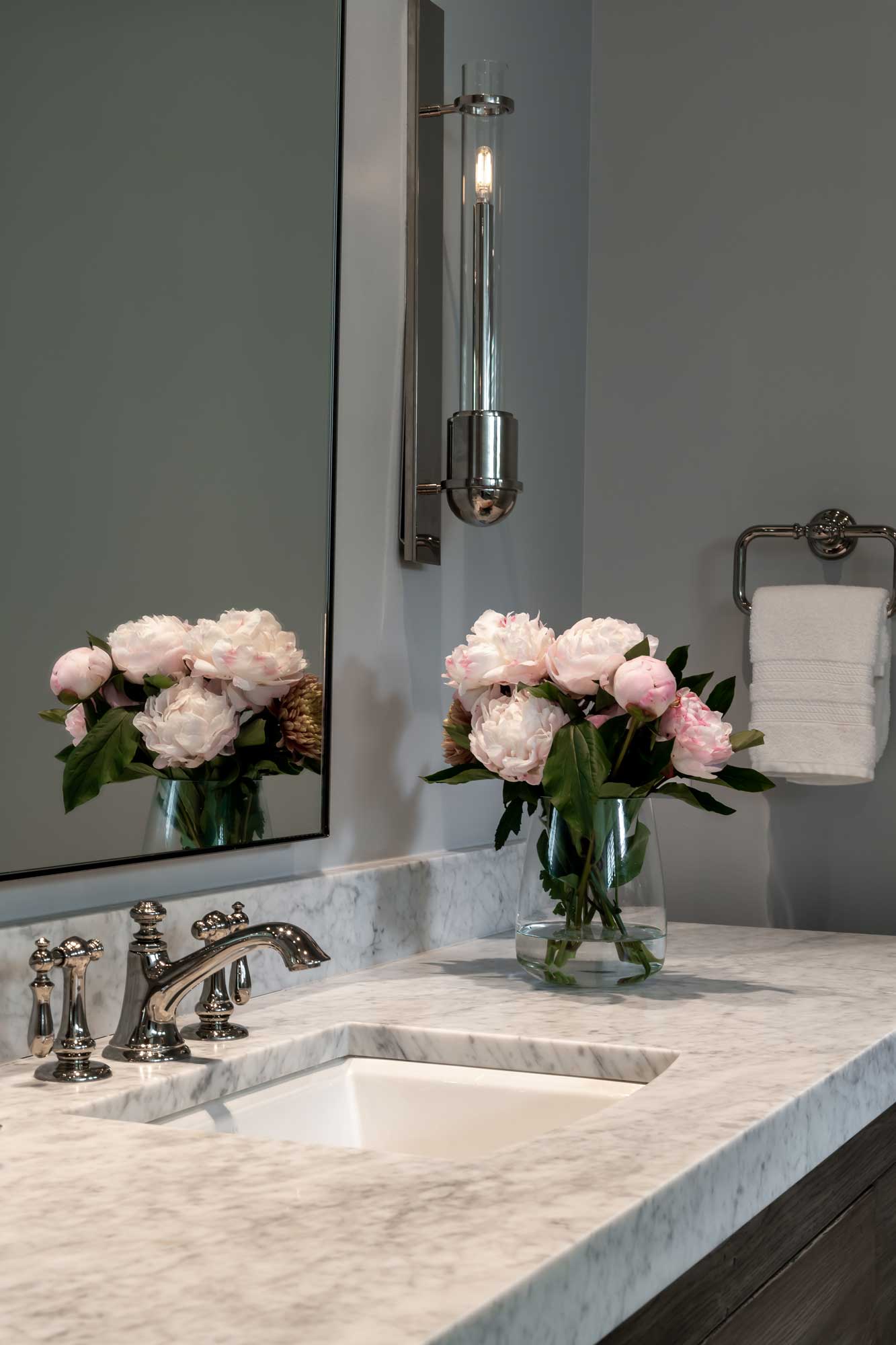
What is marble and how is it formed?
Marble is a metamorphic stone, like granite or soapstone: it takes centuries to form its characteristic chemical composition. Thus, marble can only be found among the oldest areas of the Earth’s crust.
Marble begins its geological life as limestone. Once it has been exposed to years of extreme pressure and heat, its molecular structure and appearance starts to change. This re-crystallization of carbonate minerals alters the sediment’s structure, so that its primary mineral composition is significantly different from that of limestone.
What is marble veining?
Marble “veining” refers to the streaks and specks present in the stone. Veining occurs, and is dependent on, a quarry’s mineral composition. When water deposits minerals within the stone, it then evaporates, leaving trace amounts of those minerals in the stone.
What do I need to know about marble?
Marble comes from all over the world, but it is most prevalent in Italy, Spain, India, and China. The most well-known stones are usually those from Italy, such as Calacatta and Carrara.
As marble is a natural stone, every slab of it is completely different; like a fingerprint. However, marble can still be classified into types, depending on aspects such as appearance, where it came from, mineral composition, and absorption rate.
The absorption rate is particularly notable when it comes to marble. Marble is much more porous than other stones, making it “softer” than other popular stone choices, like granite or quartz. However, there is variability in the absorption rates, and therefore “softness,” of marble stones, which is important to consider if you are interested in purchasing marble for a project in your home. Marble can be either calcitic (“soft”) or dolomitic (“hard”). The “harder” your marble, the lower the risk of stains.
Why is marble so popular?
Marble is classic. Marble is timeless. Marble is luxury.
Marble is so highly regarded around the globe and throughout history, due to its elegance, warmth, and character. Not only does its versatility make it a beautiful choice for any design style, but, the fact that no two slabs of marble are the same, ensures a unique touch.
With the right maintenance and sealant, marble has the potential to last a lifetime. Since it is a such versatile stone, switching an interior or exterior style to be more traditional or contemporary, while maintaining a sophisticated and classy look, is not a problem. This is a major contributor to marble’s popularity.
Additionally, marble is equated with luxury and value. Although it is a pricier stone, the overall cost may not be as drastic when considering certain aspects. For example, if you are looking for a specific edge profile, cut, or arch, marble may be less expensive than other stones, like granite, due to its softer composition. Also, some individuals do not mind spending a little extra on marble, because they know the veining will be subtle, unlike with some granites, and the depth of the stone, which is not attainable with engineered quartz, will add significant character to their space.
Is Marble the Right Choice for You?
When trying to decide if marble is the right choice for your next home project, there are many aspects to consider, primarily concerning your specific lifestyle.
Are you predisposed to keep things spotless and neat? Do you enjoy baking and tend to spend considerable time in your kitchen? If these traits describe you, marble may be the perfect choice for you! However, if you have children who tend to spill, or a busier lifestyle with little time spent in the kitchen, you may want to look elsewhere for your ideal stone type.
Marble is wildly popular for the reasons mentioned previously, but it may not be the right choice for your home project. You have to consider both what you would be using the stone for and your lifestyle. If you are choosing marble for a decorative build, it is likely going to be a wonderful choice. However, if you are considering marble for one of your home’s surfaces, such as a countertop, vanity, or flooring, this is primarily when you will have to keep in mind your particular lifestyle.
And here is why:
The Pro’s & Con’s of Marble
Pro-
As we previously stated, marble is a wonderful choice for a countertop for those who love to bake; this is due to the stone’s great heat resistance, as it does not absorb energy or heat very quickly. Unlike engineered quartz, marble can withstand much higher temperatures, making it an ideal choice for those who wish to set down a hot pan, without fear of damaging the stone. Furthermore, this heat resistance makes is a suitable choice for those living in hotter climates.
Con-
Marble can stain, scratch, and etch.
Because it is a porous, natural stone, marble is susceptible to stains and etching. Likewise, as it is a softer stone, it can scratch. Obviously, this is not ideal for those looking to utilize marble for countertop, vanity, or flooring. However, this is when your lifestyle comes into play.
Any professional supplying you with the stone will no doubt have your marble sealed when it is installed (I can assure you we do, here at Stone Fabricators!). Sealing the stone makes the surface less porous, and therefore less susceptible to stains. However, it does not mean you can leave a spill sitting for hours; it simply buys you enough time to clean up the spill without panicking that you have ruined your stone. Additionally, you will need to get your stone re-sealed ever so often, depending on how much use the surface gets.
Marble is a softer, natural stone, so it can scratch. When it comes to scratching, marble is generally as hard as a copper penny, but this is still softer than other natural stone options, like granite. However, it is important to recognize that different varieties of marble are harder, and therefore less susceptible to scratching, than others.
Marble is vulnerable to etching. Etching generally refers to surface damage to the stone, caused by acids that react with the calcium carbonate composition of the marble. As with stains, your marble can etch if you allow an acidic spill to sit on the surface for an extended period of time. However, this can be circumvented depending on the finish you choose for your marble.
The most popular finish choices are polished and honed; these finishes affect both the performance and look of the marble. A polished finished resembles a high-gloss look, highlighting the veining of the marble; polished finishes make the stone less porous, but etching is more visible. Therefore, if you are utilizing marble for a kitchen countertop, a honed finish might be the better choice for you. A honed finish gives a soft, matte appearance to the marble, but it significantly reduces the appearance of etching.
It is important to note that a lot of fans of marble actually enjoy the etching, as it shows the weathering of the stone throughout time and showcases its history.
With all this being said, understanding your lifestyle is a significant factor in determining whether or not marble is the right choice for you. If you are less susceptible to spilling and are more likely to immediately clean-up said spill, the potential for stains and etching may not be as drastic for you.
Lastly, you should know that, in most non-extreme cases, stains, scratches, and etching to your marble can be remedied by stone professionals. It just might cost you a bit!
Pro-
Marble is beautiful, and it is unique. As no two marble slabs are the same, it offers a sense of individuality for every individual who chooses marble for their home. The stone is available in nearly every color, assuring that it is pairable with every design choice, whether that be contemporary or traditional.
Con-
Marble is expensive. There is a reason that this stone exudes luxury and value; it costs a lot, specifically white marble.
However, there are reasons that marble is costly.
Most people do not cheap-out on the stone, because poor-quality marble looks unsettling. If you are looking to purchase more than one “piece” of the stone, spending less may mean that the seams and veining will not line up when the two pieces of stone are placed together.
Although marble is not the most economical choice of stone, it is certainly not the most expensive. In fact, it is your cheapest natural stone option, with the exception of granite.
Pro-
Although it is initially a hefty cost, in comparison to other stone, marble can increase the value of your home. When it comes to re-sale value of a house, marble is your safest bet. As we mentioned previously, marble is a wonderful choice for any design aesthetic, and, when properly maintained, it can only increase your home’s value.

